
A tunicate is an exclusively marine invertebrate animal, a member of the subphylum Tunicata. This grouping is part of the Chordata, a phylum which includes all animals with dorsal nerve cords and notochords. The subphylum was at one time called Urochordata, and the term urochordates is still sometimes used for these animals. They are the only chordates that have lost their myomeric segmentation, with the possible exception of the seriation of the gill slits. However, doliolids still display segmentation of the muscle bands.

Ascidiacea, commonly known as the ascidians or sea squirts, is a paraphyletic class in the subphylum Tunicata of sac-like marine invertebrate filter feeders. Ascidians are characterized by a tough outer "tunic" made of a polysaccharide.

Clavelina is genus of sea squirts, containing the following species:

Phlebobranchia is an order of sea squirts in the class Ascidiacea, first described by Fernando Lahille in 1886.
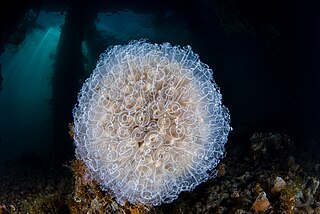
Clavelina lepadiformis, common name the light-bulb sea squirt, is a colonial sea squirt native to the NE Atlantic Ocean.
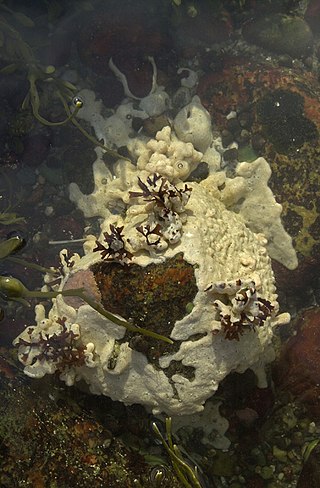
Aplousobranchia is an order of sea squirts in the class Ascidiacea, first described by Fernando Lahille in 1886. They are colonial animals, and are distinguished from other sea squirts by the presence of relatively simple pharyngeal baskets. This provides the etymology of their name: in ancient greek, ἁ.πλοος-ους (ha.ploos-ous) means "simple". The posterior part of the abdomen contains the heart and gonads, and is typically larger than in other sea squirts.
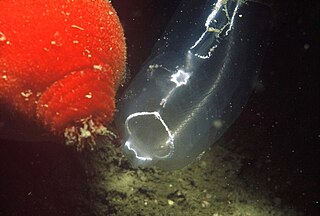
Clavelina sabbadini is a species of tunicate, in the genus Clavelina. Like all ascidians, these sessile animals are filter feeders.

Pycnoclavella diminuta, known as the white-spotted sea squirt, white-spot ascidian, and white-spotted ascidian, is a species of tunicate, in the genus Pycnoclavella. Like all ascidians, these sessile animals are filter feeders.

Nephtheis fascicularis, commonly called the lollipop tunicate, lollipop coral, or blue palm coral, is a species of tunicate that is native to the shallow reefs of Indonesia. It is the only species in its genus Nephtheis. They are not photosynthetic, and live on plankton and small organic particles obtained from the water currents. The branched stems are formed by tiny polyps called zooids. Despite their name and appearance, they and other sea squirts are unrelated to true corals.
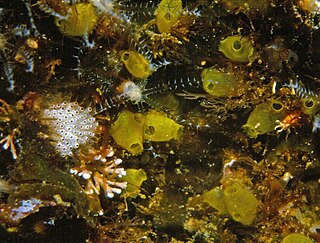
Ecteinascidia is a sea squirt genus in the family Perophoridae.

Ecteinascidia turbinata, commonly known as the mangrove tunicate, is a species of tunicate in the family Perophoridae. It was described to science in 1880 by William Abbott Herdman. The cancer drug trabectedin can be isolated from this species.

Perophora is a sea squirt genus in the family Perophoridae. Most species are found in shallow warm water but a few are found in higher latitudes. A colony consists of a number of zooids which bud off from a long slender stolon.

Perophora namei is a sea squirt species in the genus Perophora found in Central Indo-Pacific.

Ascidiella aspersa, the European sea squirt, is a species of solitary sea squirts native to the northeastern Atlantic, from the Mediterranean Sea to Norway. They possess oval bodies up to 50 to 130 mm in length. Their branchial siphons are conical and positioned at the top of the body. They possess six to eight lobes. The atrial siphons are located at the upper third of the side of the body and possess six lobes. The body is covered by a firm transparent test that is greyish to brown in color. The test often snag detritus that remain loosely attached to the animal. When expanded, at most 40 tentacles can be observed on the inside surface of the branchial wall. Both the openings of the branchial and atrial siphons possess lighter colored ridges on their rims. They may also be frilled at times. A. aspersa are attached to the substrates by the left side of their bodies. They can be found in dense groups of unfused individuals on hard surfaces like rocks. at depths of up to 90 m (300 ft).

Didemnum molle is a species of colonial tunicate in the family Didemnidae. It is commonly known as the tall urn ascidian, the green barrel sea squirt or the green reef sea-squirt. It is native to the Red Sea and the tropical waters of the Indo-Pacific region.
Perophora viridis, the honeysuckle tunicate, is a species of colonial sea squirt in the genus Perophora found in the tropical western Atlantic Ocean.
Perophora japonica is a species of colonial sea squirt in the genus Perophora, native to the North Indo-Pacific. It has spread to several other parts of the world including the south coast of Britain, France, the Netherlands and the west coast of the United States.
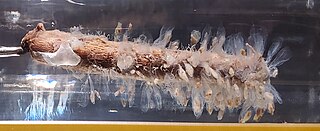
Perophora regina is a species of colonial sea squirt in the genus Perophora. It is native to the tropical western Atlantic Ocean where it is found growing on mangrove roots on the Belize Barrier Reef.

Distomus variolosus is a species of tunicate or sea squirt in the family Styelidae. It is native to the northeastern Atlantic Ocean where it lives on the seabed, typically on the stems and fronds of kelp.
















